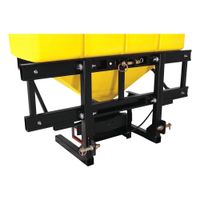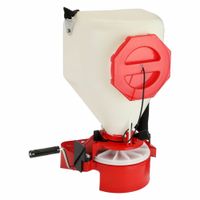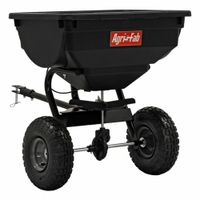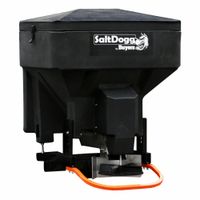Call +(254) 703 030 000 / 751 483 999 / 721 704 777
- Home
- Outdoor Equipment
- Spreaders
.....Read More
Frequently Asked Questions
What is the best type of spreader for large areas?
The best type of spreader for large areas is a broadcast spreader, also known as a rotary spreader. This type of spreader is designed to cover extensive areas efficiently and uniformly. It works by using a spinning disc mechanism that throws the material, such as seeds, fertilizer, or other granular products, in a wide arc. This allows for quick coverage of large spaces, reducing the time and effort required compared to other types of spreaders.
Broadcast spreaders are available in both walk-behind and tow-behind models. Walk-behind models are suitable for moderately large areas and are manually pushed by the operator. They are ideal for residential lawns or medium-sized plots. Tow-behind models, on the other hand, are designed for very large areas and can be attached to tractors or riding mowers, making them perfect for commercial use, golf courses, or expansive agricultural fields.
One of the key advantages of broadcast spreaders is their ability to adjust the spread width, allowing for customization based on the specific needs of the area being treated. They also typically have a large hopper capacity, which means fewer refills and more efficient operation.
However, it is important to note that while broadcast spreaders are excellent for large areas, they may not be as precise as drop spreaders, which are better suited for smaller, more controlled applications. Proper calibration and operation are essential to ensure even distribution and to avoid over-application or waste.
In summary, for large areas, a broadcast spreader is the most effective choice due to its wide coverage, efficiency, and adaptability to different terrains and materials.
How do I choose the right spreader for my needs?
To choose the right spreader, consider the following factors:
1. **Type of Material**: Determine what you will be spreading—fertilizer, seed, salt, or other materials. Some spreaders are designed for specific materials, while others are versatile.
2. **Spreader Type**:
- **Broadcast/Rotary Spreaders**: Ideal for large areas; they distribute material in a wide, circular pattern.
- **Drop Spreaders**: Offer precision, dropping material directly below; best for small, targeted areas.
- **Handheld Spreaders**: Suitable for small gardens or spot treatments.
- **Tow-Behind Spreaders**: Attach to tractors or ATVs for large properties.
3. **Area Size**: Match the spreader to the size of your lawn or garden. Larger areas benefit from broadcast or tow-behind spreaders, while smaller areas may only need a handheld or drop spreader.
4. **Terrain**: Consider the landscape. Uneven or hilly terrain may require a spreader with larger wheels for stability.
5. **Capacity**: Choose a spreader with a hopper size that matches your needs. Larger hoppers reduce the need for frequent refills but may be heavier and harder to maneuver.
6. **Adjustability**: Look for spreaders with adjustable settings to control the flow rate and spread width, ensuring even distribution.
7. **Durability and Build Quality**: Opt for spreaders made from high-quality materials like rust-resistant metals or durable plastics to withstand frequent use and harsh conditions.
8. **Budget**: Determine your budget. While higher-end models offer more features and durability, there are affordable options that can meet basic needs.
9. **Brand and Reviews**: Research brands and read customer reviews to gauge reliability and performance.
10. **Ease of Use and Maintenance**: Consider models that are easy to assemble, operate, and clean, with accessible parts for maintenance.
By evaluating these factors, you can select a spreader that efficiently meets your specific requirements.
Can spreaders be used for both fertilizer and ice melt?
Yes, spreaders can be used for both fertilizer and ice melt, but there are important considerations to ensure effectiveness and prevent cross-contamination.
1. **Type of Spreader**: There are two main types of spreaders: broadcast (rotary) and drop spreaders. Both can be used for fertilizer and ice melt, but broadcast spreaders are more common for ice melt due to their ability to cover larger areas quickly.
2. **Cleaning**: After using a spreader for one material, it is crucial to thoroughly clean it before switching to another. Residual fertilizer can damage surfaces when spreading ice melt, and leftover ice melt can harm plants when spreading fertilizer.
3. **Material Compatibility**: Ensure the spreader is compatible with both materials. Some spreaders may corrode if used with certain ice melts, especially those containing salt. Stainless steel or plastic components are preferable for dual use.
4. **Calibration**: Proper calibration is essential for accurate application. Fertilizers and ice melts have different granule sizes and weights, requiring adjustments to the spreader settings to ensure even distribution.
5. **Seasonal Use**: Typically, spreaders are used for fertilizer in the growing seasons (spring and fall) and for ice melt in winter. This seasonal use can help manage the cleaning and maintenance schedule.
6. **Storage**: Store the spreader in a dry place to prevent rust and damage, especially after using ice melt, which can be corrosive.
By following these guidelines, a single spreader can effectively serve dual purposes, providing convenience and cost savings.
What is the difference between a broadcast spreader and a drop spreader?
A broadcast spreader and a drop spreader are both tools used for distributing granular materials like seeds, fertilizers, or pesticides over a lawn or garden, but they operate differently and are suited for different tasks.
A broadcast spreader, also known as a rotary spreader, disperses material in a wide, fan-like pattern. It uses a spinning disk to fling the material outward, covering a broad area quickly. This type of spreader is ideal for large lawns or fields because it can cover a lot of ground in a short amount of time. However, its wide distribution pattern can lead to uneven coverage, especially near edges or in windy conditions, as the material can be spread beyond the intended area.
In contrast, a drop spreader releases material directly beneath the spreader in a controlled, precise manner. It has a row of holes at the bottom of the hopper that allows the material to fall straight down as the spreader is pushed forward. This precision makes drop spreaders ideal for smaller areas or when working near flower beds, sidewalks, or driveways where you want to avoid overspreading. The main drawback is that drop spreaders cover a narrower path, requiring more passes to cover the same area as a broadcast spreader.
In summary, the choice between a broadcast and a drop spreader depends on the size of the area, the need for precision, and the type of material being spread. Broadcast spreaders are best for large, open areas where speed is a priority, while drop spreaders are better for smaller, more intricate spaces where accuracy is crucial.
How do I calibrate a spreader for accurate application?
1. **Read the Manual**: Start by reviewing the spreader's manual for specific calibration instructions and recommended settings for different materials.
2. **Select the Right Material**: Choose the material you plan to spread, such as fertilizer or seed, and note its application rate from the product label.
3. **Prepare the Spreader**: Ensure the spreader is clean and in good working condition. Check for any worn or damaged parts and replace them if necessary.
4. **Measure a Test Area**: Mark a test area, typically 1000 square feet, using stakes and string or a measuring tape.
5. **Weigh the Material**: Weigh a specific amount of the material, usually enough to cover the test area based on the recommended application rate.
6. **Set the Spreader**: Adjust the spreader settings according to the manual or product label. This usually involves setting the gate opening size.
7. **Conduct a Test Run**: Fill the spreader with the weighed material and spread it over the test area. Walk at a consistent pace to ensure even distribution.
8. **Measure Remaining Material**: After spreading, weigh the remaining material to determine how much was applied.
9. **Calculate Application Rate**: Subtract the remaining material from the initial weight to find the amount applied. Compare this to the recommended rate.
10. **Adjust Settings**: If the application rate is too high or too low, adjust the spreader settings accordingly and repeat the test run until the desired rate is achieved.
11. **Record Settings**: Once calibrated, record the settings for future reference to ensure consistent application.
12. **Regular Checks**: Periodically recalibrate the spreader, especially when changing materials or after maintenance, to maintain accuracy.
Are vehicle-mounted spreaders more efficient than walk-behind spreaders?
Vehicle-mounted spreaders are generally more efficient than walk-behind spreaders in several ways. They cover larger areas more quickly due to their ability to be attached to vehicles like trucks or tractors, which can travel at higher speeds than a person walking. This makes them ideal for large-scale applications such as agricultural fields, golf courses, or extensive lawns.
The capacity of vehicle-mounted spreaders is significantly higher, allowing them to hold more material, reducing the need for frequent refills. This is particularly advantageous for spreading fertilizers, seeds, or de-icing materials over vast areas, enhancing productivity and reducing downtime.
Precision is another area where vehicle-mounted spreaders often excel. Many models are equipped with advanced technology such as GPS and variable rate control, which ensures even distribution and minimizes waste. This precision is crucial for optimizing resource use and achieving uniform coverage, which can be more challenging with walk-behind spreaders due to human error and fatigue.
However, walk-behind spreaders offer advantages in smaller or more intricate areas where maneuverability is essential. They are more suitable for residential lawns or gardens where precision in tight spaces is required. They are also more cost-effective for small-scale applications and require less maintenance compared to their vehicle-mounted counterparts.
In summary, vehicle-mounted spreaders are more efficient for large-scale, open-area applications due to their speed, capacity, and precision. Walk-behind spreaders, while less efficient in terms of coverage and speed, are better suited for smaller, more detailed work. The choice between the two depends on the specific needs of the task at hand.
What maintenance is required for spreaders?
Maintenance for spreaders involves several key tasks to ensure optimal performance and longevity:
1. **Regular Cleaning**: After each use, clean the spreader thoroughly to remove any residual material, such as fertilizer or salt, which can cause corrosion or clogging.
2. **Inspection**: Regularly inspect the spreader for any signs of wear or damage. Check the hopper, wheels, and spreading mechanism for cracks, rust, or other issues.
3. **Lubrication**: Lubricate moving parts, such as the axle, wheels, and gears, to ensure smooth operation. Use appropriate lubricants as recommended by the manufacturer.
4. **Calibration**: Periodically calibrate the spreader to ensure accurate distribution of materials. This involves adjusting the settings to match the material being spread and the desired application rate.
5. **Tire Maintenance**: Check the tires for proper inflation and wear. Replace or repair tires as needed to maintain stability and maneuverability.
6. **Rust Prevention**: Apply a rust inhibitor to metal parts to prevent corrosion, especially if the spreader is used in damp or salty conditions.
7. **Storage**: Store the spreader in a dry, sheltered area when not in use. Cover it to protect against dust and moisture.
8. **Parts Replacement**: Replace worn or damaged parts promptly. Keep spare parts on hand for quick repairs.
9. **Cable and Control Maintenance**: Inspect and adjust cables and controls to ensure they are functioning correctly. Replace any frayed or broken cables.
10. **Manual Review**: Refer to the manufacturer’s manual for specific maintenance guidelines and recommended service intervals.
By following these maintenance steps, you can extend the life of your spreader and ensure it operates efficiently.
How do I prevent clogging in my spreader?
To prevent clogging in your spreader, follow these steps:
1. **Choose the Right Material**: Use high-quality, dry, and free-flowing materials. Avoid damp or clumpy products that can easily cause blockages.
2. **Proper Storage**: Store materials in a dry place to prevent moisture absorption, which can lead to clumping and clogging.
3. **Regular Cleaning**: Clean the spreader after each use. Remove any residual material and wash the spreader to prevent buildup.
4. **Check for Obstructions**: Before use, inspect the spreader for any obstructions or leftover material from previous applications.
5. **Adjust Settings**: Ensure the spreader settings are appropriate for the material being used. Incorrect settings can lead to uneven distribution and clogging.
6. **Use a Screen or Sieve**: Place a screen or sieve over the hopper to filter out large particles or debris that could cause clogs.
7. **Lubricate Moving Parts**: Regularly lubricate the spreader's moving parts to ensure smooth operation and reduce the risk of clogging.
8. **Avoid Overfilling**: Do not overfill the hopper, as this can lead to compaction and clogging. Fill it to the recommended level.
9. **Operate at the Right Speed**: Maintain a consistent and appropriate speed while operating the spreader to ensure even distribution and prevent clogging.
10. **Perform Regular Maintenance**: Regularly check and maintain the spreader, including the calibration and condition of parts, to ensure optimal performance.
By following these steps, you can minimize the risk of clogging and ensure your spreader operates efficiently.
Can I use a spreader for both sand and salt?
Yes, you can use a spreader for both sand and salt, but there are important considerations to ensure optimal performance and longevity of the equipment.
1. **Type of Spreader**: Choose a spreader designed for multi-material use. Some spreaders are specifically designed for either sand or salt, while others can handle both. A broadcast or rotary spreader is generally more versatile for this purpose.
2. **Material Flow**: Sand and salt have different flow characteristics. Sand is heavier and may require a spreader with a more robust mechanism to handle the weight and prevent clogging. Salt, especially when damp, can clump and may need a spreader with an agitator to ensure even distribution.
3. **Corrosion Resistance**: Salt is corrosive, so ensure the spreader is made of or coated with materials resistant to rust and corrosion. Stainless steel or plastic components are preferable.
4. **Cleaning and Maintenance**: After using salt, thoroughly clean the spreader to prevent corrosion. Rinse with water and dry completely. Regular maintenance will extend the life of the spreader.
5. **Calibration**: Adjust the spreader settings when switching between sand and salt to ensure the correct application rate. Sand typically requires a higher setting due to its density.
6. **Environmental Considerations**: Be mindful of the environmental impact. Excessive salt can harm vegetation and wildlife, so use it judiciously.
By selecting the right type of spreader and maintaining it properly, you can effectively use it for both sand and salt applications.
What is the best spreader for uneven terrain?
The best spreader for uneven terrain is typically a broadcast spreader, specifically a tow-behind or push model with large pneumatic tires. These spreaders are designed to handle rough and uneven surfaces more effectively than drop spreaders. The large pneumatic tires provide better traction and stability, allowing the spreader to move smoothly over bumps and dips without tipping over or getting stuck.
A broadcast spreader works by using a spinning disk to distribute the material, such as seed, fertilizer, or lime, in a wide, even pattern. This mechanism is advantageous on uneven terrain because it can cover a larger area with each pass, reducing the need to navigate difficult terrain multiple times.
When selecting a broadcast spreader for uneven terrain, consider models with adjustable spread patterns and flow rates to ensure precise application, even on slopes or irregular surfaces. Look for durable construction materials, such as rust-resistant hoppers and sturdy frames, to withstand the challenges of rough terrain.
Additionally, some models come with features like a deflector shield to control the spread pattern and prevent material from being wasted or thrown into unwanted areas. A spreader with a high-capacity hopper can also be beneficial, as it reduces the frequency of refilling, allowing for more efficient coverage of large or difficult areas.
Overall, a tow-behind or push broadcast spreader with large pneumatic tires, adjustable settings, and durable construction is the best choice for spreading materials on uneven terrain.




